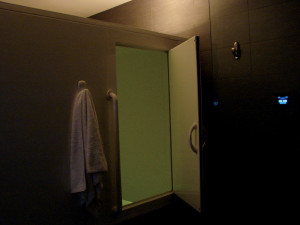An Altered State: Experiencing Zero Gravity

Assignment: “I’d like for you to float for an hour in a shallow tank of water that has about 1,200 pounds of Epsom salt dissolved in it. Oh, and by the way, there will be no light or sound, so it’s total sensory deprivation.”
When my editor assigned me to write about the experience of the flotation tank at the newly opened Zero Gravity Institute, I was simultaneously intrigued and a little nervous. I’m a swimmer, so floating in water is, after all, no big deal for me. But the whole sensory deprivation thing? What if I felt claustrophobic and panicked? And, more importantly, what was the point?
Why Float?
According to the Zero Gravity Institute’s website, the concept of Restricted Environmental Stimulation Therapy (REST) first came about in 1954. John C. Lilly, a physician, neuroscientist, and psychoanalyst at the National Institute of Mental Health, set out to test the idea that the brain is at rest when deprived of external stimuli. Some studies over the years have shown that floating promotes stress relief and relaxation and helps to lower blood pressure, release endorphins, and relieve chronic pain—to name just a few of its many purported benefits.
 How Does It Work?
How Does It Work?
The concept of floating is simple: The floater rests in a shallow solution (about ten inches) of salt water, which keeps him or her naturally buoyant, eliminating the body’s need to exert force to stay afloat. The water is kept at a constant 93.5 degrees, the same temperature as the skin, which negates any perception of separation between the body and the water.
Because the flotation tank is dark and soundless, the brain is relieved from processing external stimuli. This complete lack of stimulation initiates a “parasympathetic response,” thereby slowing down the heart rate, dilating blood vessels, and allowing the body to repair itself.
The Zero Gravity Institute
I was fascinated by the concept of floating and curious to see how it might benefit my shoulder, which has been plagued by an overuse injury brought about by my long-distance swim training. I was also looking forward to the relaxation the experience promised.
Kevin Johnson, one of the Institute’s owners, and his fellow business partners, Carol Turner-Johnson, Vincent Beall, and Jina Carter, met me in the lobby. After speaking briefly with them about the history and benefits of floating, I confessed that I was afraid of feeling claustrophobic and panicking during the experience. Johnson reassured me that the tanks at the Institute (which he designed) measured 8 x 6 x 7 feet, essentially the size of a small room. He also pointed out that each tank came equipped with a button that would allow me to turn on the lights if I needed them. Furthermore, if I were just too nervous, I could float in the tank with lights and music; however, that option, although relaxing, would not provide the same benefits as complete sensory deprivation.
My next question for Johnson was about safety—specifically, whether one ran the risk of falling asleep and drowning. He explained that the amount of salt dissolved in the water (1,200 pounds) would make it next to impossible for me to flip over without concerted effort on my part.
Finally, I asked the inevitable: What about sanitation? Johnson and Beall elaborated in great detail about the tank filtration systems, which they had designed to exceed health standards and utilize the same technology as that of municipal pools. They further explained the sanitation process between each floater, which—in addition to the water rotation and filtration inside the tank—includes a meticulous scrub down of the room it is housed in.
 My Floating Experience
My Floating Experience
The Zero Gravity Institute has four flotation rooms as well as additional rooms that they hope to eventually rent out to massage therapists and alternative healing practitioners. I was shown to a changing room where I was given a bathrobe, flip-flops, and a locker for my clothes (you float in the nude). I was then led to a relaxation room, where I was treated to 15 minutes in a massage chair that measured and scanned my body, offering just the right amount of pressure where I needed it. It was heavenly.
Finally, I made my way to the flotation suite. There was soft light and music playing when I entered the room that housed the tank in which I’d be floating; my fears of feeling claustrophobic were immediately assuaged by the tank's size. Johnson explained that both light and sound would be programmed to automatically dim after several minutes, giving me enough time to get settled. I was instructed to take a shower (conveniently located in the same room and equipped with soap, shampoo, and conditioner) and wash my hair to ensure that no excess dirt or contaminants would find their way into the water.
After I showered, I entered the tank, shut the door, and lay down.
I immediately tested Johnson’s assertion that it would be next to impossible to flip over without exerted effort on my part. Much to my amusement, he was correct; there was no way I could roll over without seriously engaging my core. With the reassurance that I was unlikely to drown, I closed my eyes and tried to relax.
Much to my surprise, the hour passed quickly. I made an effort to meditate and visualize but, eventually, I just relaxed, daydreamed, and enjoyed being in the water. At one point, I had a glimpse of a purple light behind my eyes (incidentally, the color of the crown chakra) but as soon as I became aware of it, it disappeared. There were no spiritual revelations, no burning bushes. When the lights slowly came back on, I felt calm and relaxed.
I showered once again and went to chat with the Zero Gravity folks about my experience. Although I did not have a life-changing experience or overwhelming euphoria, I did feel very good and connected to my body, which lasted well into the next few days.
The more dramatic pay-off, however, came the next morning, when I went for a swim and experienced no shoulder pain whatsoever—not even that “tweak” that has become a normal part of swimming for me these days. The effect held through my four-hour training swim that weekend. Whereas I typically have had to break up my swim just to give my shoulder a break, I was able to swim a longer distance without disruption or using a kickboard for relief. My shoulder recovery time between swims was shorter as well.
Should You Try Floating?
Seeing such a dramatic improvement for an injury that has been disrupting my training for the last two months was enough to make me schedule another float right away—specifically to follow my next long training swim.
More than that, having that hour to relax did wonders for my stress level. I have since felt more present in and connected to my body, more conscious about my choices, and less distracted by television, Internet, text messages, instant messages, deadlines…you get the idea. According to Johnson, floating can become a practice, with each session offering something a little different and the opportunity to go a bit deeper into the experience. And since one session costs less than a massage at a fancy spa, I’d say floating is well worth the old college try.






